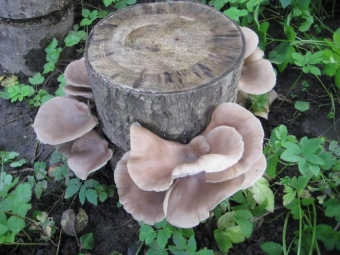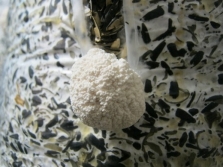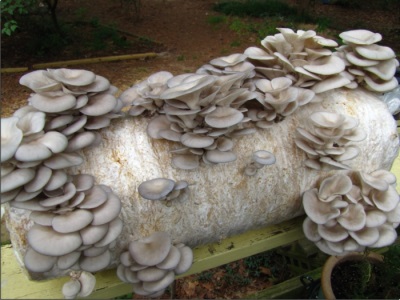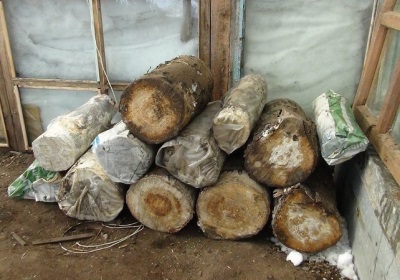Cultivation of oyster mushrooms

Growing oyster mushrooms is not a difficult process. It is quite possible to grow these mushrooms at home.
Mycelium (seeds)
The first step in growing oyster mushrooms will be the purchase of mycelium. It can be purchased from any company that grows mushrooms. Mycelium is also sold in online stores, sending it by mail. If you are growing oyster mushrooms for the first time, buy up to one kilogram of mycelium. It will become the basis for obtaining about three to four kilograms of oyster mushrooms. Mycelium can be stored in the refrigerator (up to 3 days) or freezer (up to a year).
Mycelium packages need to be opened under sterile conditions, so treat it with a disinfectant solution and use gloves.

Tips for acquiring mycelium:
- Choose a trusted supplier with recommendations.
- Buy a trial batch before purchasing a large quantity.
- Find out the variety and strain of oyster mushrooms, mycelium growth rate, resistance to mold, and also do not forget to pay attention to the shelf life.
- Determine the temperature inside the mycelium (it is important that it is not overheated during delivery) - +20 degrees will be optimal.
- You should not see black or green spots on the mycelium.
- The shade of mycelium is normally bright orange. A little yellow exudate may be added to it.

How to grow at home
For independent cultivation of oyster mushrooms, two methods are used:
- Intensive
- Extensive


Intensive way
This is the name given to the cultivation of mushrooms on a substrate placed in a plastic bag.
Its advantages:
- You can harvest mushrooms regardless of the season.
- Mushrooms ripen fairly quickly.
- You can make money by selling mushrooms.
Its cons:
- Need financial investment.
- You need a suitable room in which a certain microclimate is maintained.

Room selection
It is desirable to grow oyster mushrooms in a room that has:
- good thermal insulation;
- good ventilation system;
- height 3-5 meters;
- artificial lighting about 100 lux;
- source of clean water and sewerage.

Suitable premises may be:
- Cellar;
- Basement;
- poultry house;
- Fruit storage;
- Cowshed or pigsty;
- Granary;
- Vegetable store;
- Greenhouse;
- Garage;
- Pantry.
Remember that when fruiting on oyster mushrooms, a lot of spores appear that can cause allergies, and therefore the room where mushrooms are grown must be far from living rooms.

substrate
The next step is to prepare the substrate.
Oyster mushrooms are grown on:
- Sunflower husk;
- barley straw;
- Buckwheat husk;
- wheat straw;
- crushed corn on the cob;
- Shavings or sawdust of deciduous trees.
Beginners should choose straw, husks or husks as a substrate, since it is more difficult to grow mushrooms on sawdust and shavings. Make sure that the raw material is clean and free of mold. For a kilogram of mycelium, you need about ten kilograms of substrate. It should be crushed to obtain a fraction of 4-5 centimeters.



Also important is the heat treatment of raw materials, which will exclude its infection and at the same time moisten the substrate.The crushed raw material is placed in a large volume container and completely filled with water, and then boiled for about two hours or less (the softer the raw material, the less it is boiled). The water is drained and the raw material is cooled to +25+28 degrees.
The result should be a wet substrate. To check if the raw material is not waterlogged, you should squeeze it in your hands and see if water is flowing (a few drops may appear, this is acceptable). Substrate treatment can be performed not only with hot water, but also with steam. Note that steam can be poured over both dry and already moistened substrate.

Mycelium bookmark
The substrate is placed in polyethylene, picking up the bags so that in the end there are about five kilograms of raw materials in one bag. Pre-disinfect the bags - first they need to be washed, and then soaked for an hour in a 1-2% bleach solution. After this treatment, start filling the bags with the substrate. Every 5-6 centimeters of raw materials put mycelium in a bag with a layer of about 0.5 centimeters. So layer by layer fill the bags to the top so that the last layer is the substrate.
You can also simply mix the mycelium and the substrate so that the total mass of mycelium is 3-5 percent for mycelium from domestic producers and 1.6-2.5 percent for mycelium from an imported manufacturer. Fill bags with this mixture, and then tamp it tightly.
Having tied the bag, perforation must be made over its entire surface in a checkerboard pattern. Let the distance between the holes or slots, the size of which will be 1-2 centimeters, be 10-15 centimeters.

Incubation
The next 10-25 days is the incubation period. By placing blocks with seeded substrate in the place where you will grow mushrooms.
In this room, maintain the temperature between 18 and 22 degrees Celsius.The room also needs to be ventilated several times daily, but make sure that flies do not enter it.
Inside the bags in the first three to four days the temperature will rise and it is important to prevent the substrate from heating more than +30 degrees so that the mycelium does not die. To lower the temperature, you can use a fan by pointing it at the blocks with mycelium. At this stage, it is not necessary to illuminate the blocks. After three days, the threads of the mycelium will become noticeable in the thickness of the substrate, and after about ten days they will completely fill the mushroom blocks. As a result, the blocks will become filled with a dense homogeneous mass, which will have a white color and a mushroom smell.

Harvesting
The last stage of growing oyster mushrooms is fruiting. To wait for it, immediately after the incubation period, you need:
- Set humidity between 90 and 95 percent.
- Set the air temperature at +10+15 degrees.
- Conduct daily airing of the room up to four times.
To maintain a high level of humidity, you can start spraying the floor as well as the walls with water, but be careful not to get water directly on the mushroom blocks.
If you create optimal conditions, you will soon see how the buds of oyster mushrooms appear in the slots. Mushrooms bear fruit for ten to fifteen days, rapidly increasing in size. When harvesting, do not cut oyster mushrooms, but twist them out of the substrate. The color of the mushroom cap is affected by lighting. Know that the more light gets on the mushrooms, the darker the oyster mushroom caps will be.
Having collected the first crop, you should ventilate the room and wait for the second wave of fruit bodies to appear in about two weeks. At the same time, try to maintain the same conditions that you created for the first harvest of mushrooms.Also, after the first crop is harvested, it is recommended to check the blocks and if they are found with mold, then take them out of the room, leaving only those that are not infected.

In total, mushrooms can bear fruit up to four times, but the largest harvest is noted in the first two waves (they give about 75 percent). After harvesting the fourth wave, the blocks are replaced by others. Used blocks can be used as fertilizer in the garden.
We invite you to visually get acquainted with the process of growing oyster mushrooms in the following video.
Finished mushroom blocks
An easier option for growing oyster mushrooms at home is to buy ready-made blocks from companies specializing in the industrial cultivation of these mushrooms. Such blocks are supplemented with detailed instructions on how to successfully grow oyster mushrooms at home. The buyer only needs to place the blocks in the right place and provide the right conditions for the ripening of the crop.

Extensive way
If it is not possible to obtain a suitable substrate, find a suitable room or create the conditions necessary for the fruiting of mushrooms in it, you can grow oyster mushrooms in an extensive way. It provides for the cultivation of mushrooms in the open air on stumps or logs. This method is also good for a beginner, as it requires a minimum of cash investment and labor costs. Its disadvantage is that such cultivation is influenced by the climatic conditions of the area, that is, seasonality is typical for such cultivation of oyster mushrooms.

Log preparation
Prepare logs and hemp begin at the end of winter. If there are stumps left after cutting down trees on the site, you can grow oyster mushrooms on them, however, such stumps are sown during the period with a steady positive temperature (April-May).If there are no such stumps, they take trimmings 30-50 cm long and 15-30 cm in diameter from ash, aspen, beech and other deciduous trees. Only healthy wood that is not infected with mold is suitable for growing mushrooms. Usually the logs are soaked for several days in water - this way the wood becomes moist enough for the mycelium to develop in it. However, if the wood is not dry, then it does not need to be soaked.

How to sow mycelium
Sowing mycelium on logs is possible in several ways:
- Place the mycelium in the holes in the stumps. The logs are drilled or filed, creating holes five to six centimeters deep and about a centimeter in diameter. These holes are recommended to be placed on the stumps in a checkerboard pattern. If the mycelium is grain, it should be filled into the holes, and then closed with moss or sealed with adhesive tape. If the mycelium is represented by sticks, they are inserted into the holes, and then they are sealed with plasticine.
- Lay the mycelium on the end of the log. From the hemp you need to saw off a disk two to three centimeters thick. Cover the end of the remaining stump with mycelium, lay the sawn-off disk on top and attach with nails.
- Make log columns. 100-150 grams of mycelium are laid on the end of the log (the layer will be about 1-2 centimeters), then the second log is laid, on which the mycelium is again poured. Next, the third log is laid and again sprinkled with mycelium. Thus, it is possible to make columns 1.5-2 meters high. For their greater stability, the logs used must have a sufficiently large diameter (more than 20 cm).

Sowing mycelium on logs, they are put in a place where the temperature is maintained at about +15 degrees, leaving for two or three months.It can be a basement or a barn that can be regularly ventilated. If the first two methods were used for sowing, then the logs are folded horizontally one on top of the other, and then covered with burlap or perforated film. In the third method of sowing, logs are placed vertically in several rows, filling the gaps between them with moistened straw or sawdust. From the sides, such columns are also covered with burlap or film to keep a rather high humidity inside.
Planting logs
After the appearance of white plaque on the stumps, they should be planted in the ground in a shaded place. Most often this happens towards the end of spring. Holes are dug in the ground, on the bottom of which wet sawdust or wet leaves are laid. The stumps are placed in rows so that between the logs there is a distance of 35 to 50 centimeters. Trimmings are immersed in the ground by about 10-15 centimeters. Further, in case of dry weather, carefully water the soil around the stumps.

Harvesting
The first oyster mushrooms begin to appear in August. If the autumn turns out to be protracted, then the harvest can be harvested until November. In winter, hemp is covered with leaves or straw. They can also be covered with spruce branches.

You can get a mushroom crop from such a plantation of stumps for up to five years. At the same time, the maximum fruiting of oyster mushrooms on stumps is noted in the second and third year.


















Thank you! I will try the extensive - more natural way.
Thanks for the good article!!! But for some reason, my mycelium on sticks did not go into the wood. Who will tell you what's wrong?
I didn’t go, because we don’t need sticks, but grain mycelium. It can also go with sticks, but this is a long, long time and is not guaranteed, and the living grain mycelium will immediately absorb the stump.
Grain mycelium is a living mycelium that will immediately begin to capture the stump, the only way to guarantee the maximum yield.